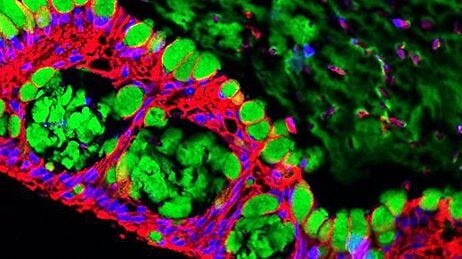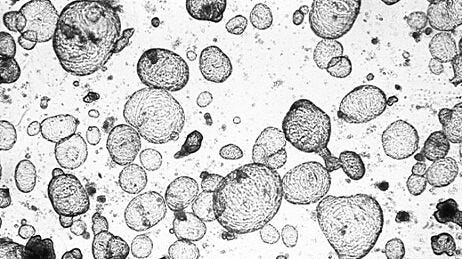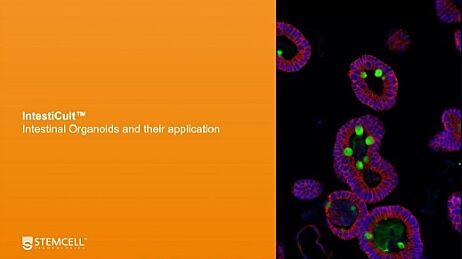Passaging Intestinal Organoids into Suspension Culture Using IntestiCult™
Intestinal organoids provide researchers with physiologically relevant in vitro cell models and constitute valuable experimental tools for probing intestinal epithelial biology and disease. However, there are limitations when working with organoid models, such as the requirement to grow within an extracellular matrix (e.g. Matrigel®), which can make working with larger numbers of organoids labor intensive.
The following protocol provides a step-by-step guide for passaging epithelial organoids from Matrigel® domes into suspension culture. This alternative method for organoid growth facilitates a higher number of organoids per well, therefore reducing the amount of work needed when establishing a large number of organoids. By seeding monolayers or 96-well plates, the amount of work is reduced for a variety of applications, such as high-throughput drug screening.
Materials and Reagents
- IntestiCult™ Organoid Growth Medium (Human) (Catalog #06010)
- 25% bovine serum albumin (BSA) in phosphate-buffered saline (PBS)
- DMEM/F-12 with 15 mM HEPES (Catalog #36254)
- Corning® Matrigel® Matrix, Growth Factor Reduced (GFR), Phenol Red-Free (e.g. Corning® Catalog #356231)
- Ultra-Low Adherent Plate for Suspension Culture (Catalog #38071)
- Y-27632 (Catalog #72302)
- D-PBS (Without Ca++ and Mg++) (Catalog #37350)
- Gentle Cell Dissociation Reagent (Catalog #07174)
Protocol
- Start with organoid cultures grown in 50 µL 50% Matrigel® domes in a 24-well plate as described in the IntestiCult™ Organoid Growth Medium (Human) Product Information Sheet (PIS).
NOTE: Each well of a 6-well suspension plate will require 4 - 6 wells of organoids (600 - 1000 organoids).
- Prepare IntestiCult™ Organoid Growth Medium (Human) as described in the PIS and warm to room temperature (15 - 25°C).
NOTE: For each well of a 6-well suspension plate, 3 mL of medium will be required.
- Add 3 mL of IntestiCult™ Organoid Growth Medium (Human) per well of a 6-well Ultra-Low Adherent Plate for Suspension Culture and incubate at 37°C for at least 1 hour.
- Thaw Corning® Matrigel® on ice; for each well of a 6-well plate, 500 µL of Matrigel® will be required. Place DMEM/F-12 with 15 mM HEPES on ice.
- Carefully remove and discard medium from each well to be passaged, without disturbing the Matrigel® dome.
- Add 1 mL of room temperature Gentle Cell Dissociation Reagent (GCDR) on top of the exposed dome in each well. Incubate at room temperature for 1 minute.
- Pre-wet a 1 mL pipette tip with GCDR; use this pipette tip to thoroughly scrape the Matrigel® dome free of the bottom of the well. Pipette the GCDR in the well up and down 2 - 3 times to break up the dome and the organoids; avoid touching the bottom of the well with the pipette tip. Ensure all pieces of Matrigel® have been rinsed free of the plate.
- Using the same pipette tip, transfer the organoid mixture to a 15 mL conical tube.
- Add 1 mL GCDR to the newly emptied well. Using a pipette tip pre-wetted with GCDR, pipette the GCDR up and down 2 - 3 times to rinse the well. Transfer the contents of the well to the 15 mL conical tube from step 8.
- Repeat steps 7 - 9 for each well to be passaged.
- Incubate the tubes at room temperature on a rocking platform set at medium speed (~40 rpm) for 10 minutes.
- Centrifuge the tubes at 290 x g for 5 minutes at 2 - 8°C. Gently pour off and discard the supernatant.
- Add 5 mL of cold DMEM/F-12 to each tube. Using a pre-wetted 1 mL pipette tip, vigorously pipette up and down 15 times to resuspend and fragment organoids.
NOTE: Avoid touching the side/bottom of the tube with the pipette tip.
- Centrifuge at 200 x g for 5 minutes. Aspirate as much supernatant as possible.
- Resuspend the organoid fragments in each tube in 500 µL cold Matrigel®. Mix thoroughly by gently pipetting up and down 10 - 15 times (try to avoid introducing air bubbles). Always keep the Matrigel® suspension on ice.
NOTE: Add 10 µM Y-27632 to increase organoid yield.
- Remove the 6-well Ultra-Low Adherent Plate from the incubator (prepared in step 3). Slowly pipette the organoid-Matrigel® suspension into the center of the medium in one well. The Matrigel® should immediately solidify and remain suspended in the medium. Repeat for each tube of organoid-Matrigel® suspension.
- Incubate at 37°C and 5% CO2. Cultures can be maintained for up to 7 days. Perform a half-medium change every 2 - 3 days, as follows:
a. Tilt the plate and use a pipette tip to gently push the Matrigel® suspension away from a corner of the well.
b. Use the pipette to gently remove 1.5 mL of medium (do not aspirate). Be careful not to remove any of the Matrigel® suspension.
c. Add 1.5 mL fresh IntestiCult™ Organoid Growth Medium (Human).
NOTE: Each well of a 6-well suspension plate should yield at least an equivalent number of organoids as 18 wells of a 24-well plate with dome cultures (1800 - 2400 organoids). - Organoids are ready to be used for other applications, such as seeding 96-well plates or establishing monolayer cultures.
Additional Resources
Request Pricing
Thank you for your interest in this product. Please provide us with your contact information and your local representative will contact you with a customized quote. Where appropriate, they can also assist you with a(n):
Estimated delivery time for your area
Product sample or exclusive offer
In-lab demonstration







